continuousWave--> Sail-Logs --> Ottawa River 2006 --> Day Five
We try to leave Mattawa, but our outboard motor objects.
DAY FIVE
| Date: | Wednesday, July 26, 2006 |
| Weather: | Rain, more Rain, and more Rain |
| Winds: | Light |
| Waves: | Calm |
| Departure: | Mattawa |
| Destination: | Rapides Des Joachim |
| Distance: | 10 miles by boat; 100 miles by bus; 100 miles by car. |
The morning starts with the usual routine on our boat trips. I get up early and make some coffee. I take care of the boat, which usually has a heavy dew on the deck and gunwales that needs to be wiped off. Chris grabs a few minutes extra sleep until the coffee is brewed.
The weather looks encouraging. The sky is still gray but at least it is not raining. We are ready for a change in scenery. We are heading back downstream towards Rapides des Joachim today. Before we leave Mattawa I'll give you a better look at the marina facilities.
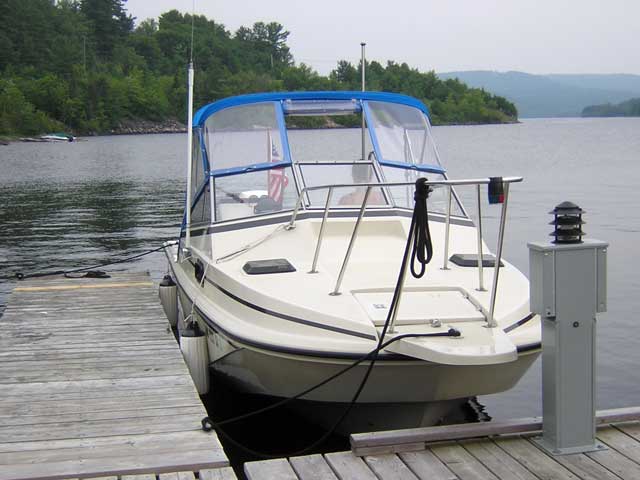
The Mattawa Marina has floating wooden docks with decent cleats. There is electricity at the slip in a convenient location. In these northern Ontario communities, electricity is almost always called "hydro", a reference to the method of generation. In this case, it is quite appropriate; we are just a mile or two from a large hydro-electric generating plant.
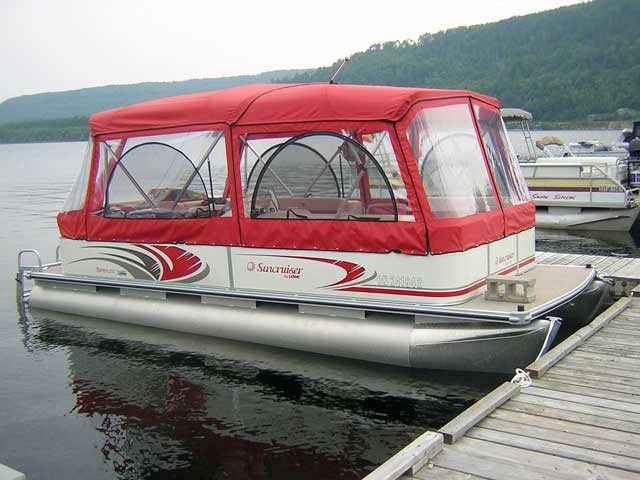
Many of the local boats in the marina are pontoon boats. This deluxe new model was the queen of that fleet. Its ground tackle was a bit unusual.

In the morning the water level below the dam is on the low side of the range. Evidence of higher water is on the stationary pier. The security fence was added a few years ago after some problems, but it was more of a nuisance than a deterrent. A young and agile local boater who forgot his key easily swung himself around it to reach his boat. You'd like to think that vandalism and theft would not be a problem in a small northern town like Mattawa, but apparently there are dishonest people everywhere.

The office and bath house at Mattawa Marina.
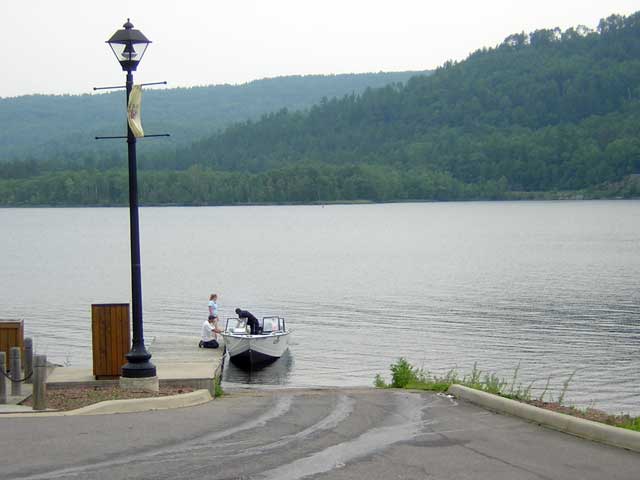
The boat launch ramp at Mattawa Marina: This facility was built about ten years ago. Details like the light fixture and the nautical stanchions with rope railings show its construction was deluxe. That's the local sheriff's boat getting ready to depart on a patrol of river.

The town's pride in their marina was reflected in this rather fancy sign erected at the entrance back in c.1990. It's missing a few letters in 2006.
By about ten o'clock we are ready to depart. We have over 50-gallons of fuel, which should be plenty to take us down to Rapides Des Joachim, the next place where we are certain we can get more. As we pull away from the dock, there is even some sunshine breaking through the clouds. After clearing the railroad trestle and the southern part of the town, we get up on plane at about 25-MPH. This gives us a fuel consumption rate of about 1.85-MPG, and that implies a range of about 92 miles. It is only 47 miles to Des Joachim, so we should have plenty of reserve.
The fuel flow rate and computation of miles-per-gallon is being performed by a NAVMAN 3100 Fuel instrument. It continuously monitors the rate of flow and gets speed data from the GPS. It shows me the instantaneous fuel economy.
About four miles downstream from Mattawa, the pitch of the engine changes slightly and the engine speed drops about 300-RPM. The fuel economy degrades to a rate of about 1.5-MPG. We have seen this problem before--the spark is cutting out on one cylinder--but it has been intermittent. It usually clears itself in a matter of a few seconds.
I advance the throttle to maintain the boat speed, and we wait for the engine to heal itself. Another mile of high fuel consumption and the engine is not cooperating. It is still running poorly. The problem has been a previously diagnosed as a loss of spark on cylinder five. I slow to an idle and then cut the engine. We drift to a stop in the middle of the river. The cowling comes off the motor, and I put my spark tester on the lead to cylinder five's spark plug. Chris cranks the motor while I watch for a spark indication on the tester; there is none.
I apply the usual wiggling of connections associated with cylinder five's ignition circuit, and we test again. There is still no spark. It looks like the motor is not going to cure itself this time.
Drifting silently in the river wilderness, we consider our options. We could run the engine like this for a while, hoping that the reluctant spark returns. With a fuel consumption rate of 1.5-MPG and about 50-gallons remaining, we'd have a range of 75-miles. That should be enough to reach Des Joachim (42-miles), but it is not quite the margin we'd like. Also, the idea of running the engine for an extended time with only five of its six cylinders working seems like a bad choice.
As we are considering the options, the weather makes its contribution. It starts to rain. This pretty much seals the deal. We are going to return to Mattawa. There is no point in running this beautiful stretch of the river in the rain for a second time. We have been anxiously anticipating a better look at its beautiful scenery, but in sunshine, not rain.
We head back upstream to Mattawa. The highlight of this portion of the trip: we spot a bald eagle sitting in a tree on the river bank. The engine never does return to normal. As we pull back into our old slip, the rain picks up its tempo. It looks like it is going to be around for a while. I can't even take the cowling off the engine to see what the heck is going on.
Mattawa is located on the Trans-Canada Highway, HWY-17. Even though it is only a two lane road, it is the major highway in this region. And it does have bus service along its route. There is a bus due in to Mattawa at 12:30 p.m. which is heading south to Pembroke and arrives there in a couple of hours. We decide the most attractive alternative to our current situation of a questionable engine is to take a bus to Pembroke and come back with our truck and trailer. We walk into town to find the bus stop and buy a ticket.
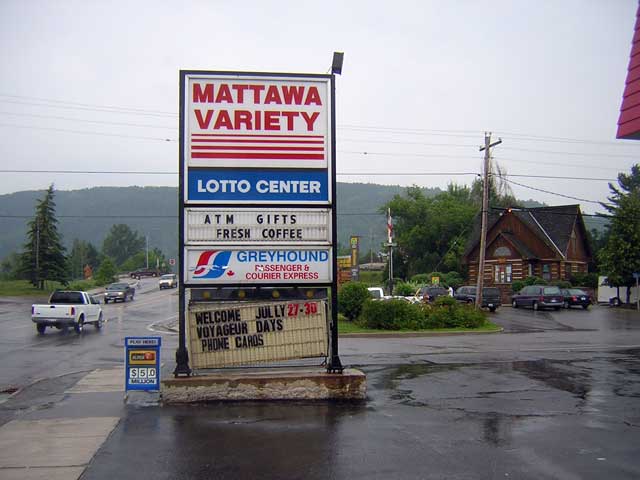
The bus station sits aside the Trans-Canada Highway, here a two-lane road curving through downtown Mattawa.
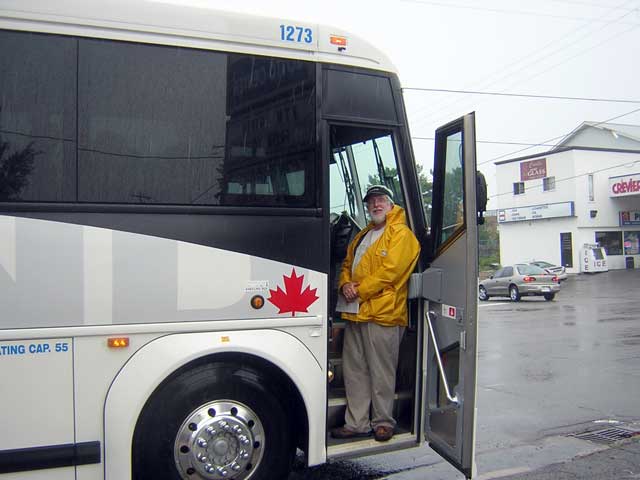
A modest $32-Canadian buys me a ticket for a 100-mile bus ride back to our launching site, Pembroke, where I can retrieve our truck and trailer and drive back here to rescue our wounded boat and motor.
The bus pulls in about 15-minutes behind schedule, at 12:45 p.m. After a very short stop, I am on the way south. Chris is staying behind with the boat. I have not been on a bus since I was about 15-years-old. The accommodations are much better these days, more like an airplane. There are individual air conditioning outlets and reading lights, and the seats recline. Chris packed me a lunch. I sit back and enjoy the ride. The low humidity of the air conditioned interior is a nice change after spending an hour in my foul weather gear in the rain.
The ride to Pembroke takes about two hours and a half. The bus driver is very nice and makes a special stop to drop me off a block away from the marina. I hop in the truck and head back to Mattawa. Oddly, it is not raining at all in Pembroke; the weather is rather decent and sunny. As soon as I get back on the highway and head north for Mattawa, the rain resumes.
On the way back to Mattawa I pick up a young fellow hitch-hiking. We have an interesting chat for two hours as I drive the 100 miles back toward the boat. As a young Canadian he holds some different views of the war in Iraq. In a remote stretch of highway the monotony of the drive in the rain is interrupted briefly by the appearance of a black bear walking out of the woods on the roadside. By the time we get back to Mattawa we have been driving in rain most of the way. I drop my young hitchhiker off on the highway and head for the marina.
Just as I get to the marina, the rain begins to lighten up. Soon it stops. Chris is glad to see me. The total time of my journey was starting to become a bit longer than she anticipated, and sitting all afternoon in the rain has dampened her spirits.
With the rain stopped, I can finally take a look at the engine. I get the cowling off and tear down the number five cylinder ignition coil, checking the ground connections. They look good. Next I check the continuity on the high-tension wire in the spark plug. It looks good. I install the spark tester and Chris cranks the engine over; there is still no spark on cylinder five. The connection on the low-voltage post of the coil looks a bit suspicious. I take it apart and bend the contact to have more tension. Another test start: Yes! We have spark on cylinder five, finally. I put the engine back together and we take the boat out for a four mile test ride up the river. The engine is running fine, just as it was for days previously.
By this time it is very late in the afternoon, close to six o'clock, and it is too late to even think about leaving by boat. We are resigned to another night in Mattawa. To make the best of it, we go back to Myrt's for another dinner. Even though we have our car now, we decide we need the exercise of the two mile uphill walk, and we drudge off on foot.
After dinner it is a humid, damp, and cool evening on the boat at the marina. There are plenty of mosquitoes in the neighborhood. Since we are the only people staying on our boat overnight, our carbon dioxide production signals an alert for every mosquito in the surrounding ten acres. There are so many of them it is almost impossible to read; you can't get more than a sentence or two in between swatting a buzzing mosquito. Our own blood stains the cabin headliner as it oozes from crushed mosquito bodies.
The nine-day narrative continues in Day Six.
Copyright © 2006 by James W. Hebert. Unauthorized reproduction prohibited!
This is a verified HTML 4.0 document served to you from continuousWave
URI: http://continuouswave.com
Last modified:
Author: James W. Hebert
This article first appeared August, 2006.







